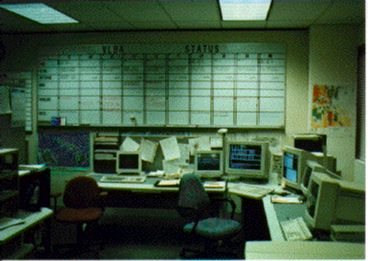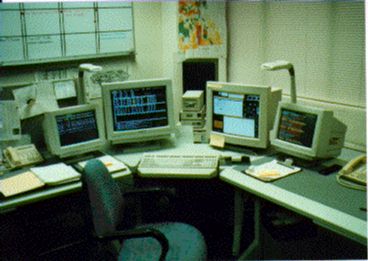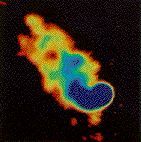VLBA Array Operations Center

 From the Array Operations Center (AOC) in Socorro, New Mexico, the
VLBA operators are able to remotely control and monitor the remote
stations over the Internet. The operators can aim the antennas,
select radio frequencies for observation, control the tape recorders
and monitor the 'health' of the equipment at every site. A real-time
display of the array's status is available for observers to also
monitor their experiment.
From the Array Operations Center (AOC) in Socorro, New Mexico, the
VLBA operators are able to remotely control and monitor the remote
stations over the Internet. The operators can aim the antennas,
select radio frequencies for observation, control the tape recorders
and monitor the 'health' of the equipment at every site. A real-time
display of the array's status is available for observers to also
monitor their experiment.
The Correlator
Data recorded at each VLBA site is sent back to the AOC for
processing at the correlator, a special-purpose high-performance computer
that combines the data from each station to produce a single set of data
from which high-resolution images can be made. The correlator performs
the complex mathematical operations that actually allow the antennas of
the VLBA, plus up to ten other radio telescopes around the world, to function
as a single instrument. The correlator, designed and built by NRAO, is
capable of performing 750 billion multiplications per second.
The Finished Product
 The
output from the correlator is provided to the astronomer(s) involved with
the observation and further analysis and processing is performed on the
data. This can occur at the AOC or at the observer's home university or
institution. Depending on their scientific objectives, researchers can
make images in a variety of forms, including both black-and-white and color
formats.
The
output from the correlator is provided to the astronomer(s) involved with
the observation and further analysis and processing is performed on the
data. This can occur at the AOC or at the observer's home university or
institution. Depending on their scientific objectives, researchers can
make images in a variety of forms, including both black-and-white and color
formats.

 From the Array Operations Center (AOC) in Socorro, New Mexico, the
VLBA operators are able to remotely control and monitor the remote
stations over the Internet. The operators can aim the antennas,
select radio frequencies for observation, control the tape recorders
and monitor the 'health' of the equipment at every site. A real-time
display of the array's status is available for observers to also
monitor their experiment.
From the Array Operations Center (AOC) in Socorro, New Mexico, the
VLBA operators are able to remotely control and monitor the remote
stations over the Internet. The operators can aim the antennas,
select radio frequencies for observation, control the tape recorders
and monitor the 'health' of the equipment at every site. A real-time
display of the array's status is available for observers to also
monitor their experiment.
